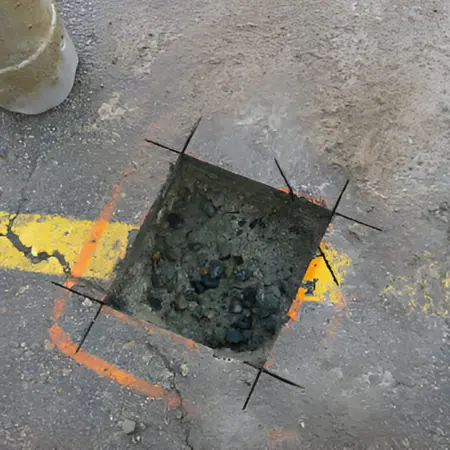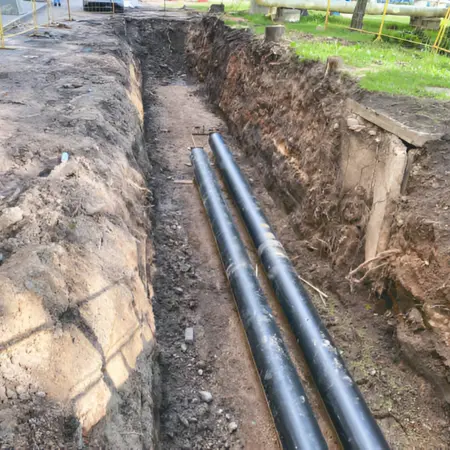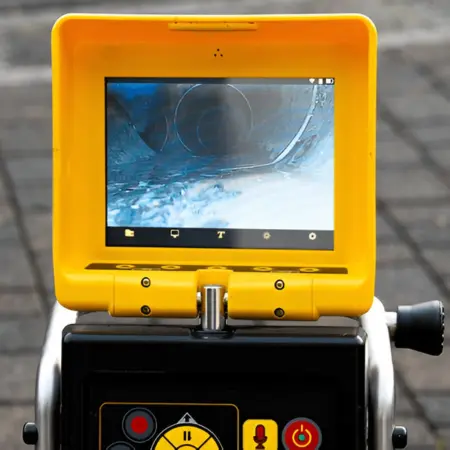Need to track your sewer line?
Don’t worry, it’s easier than you think!
Discover quick and easy methods to pinpoint it with ease.
Key Takeaways
- Check your home’s blueprints or property plans to find your sewer line.
- Inspect your basement or crawl space for visible pipes leading outside.
- Pipe locators send signals through pipes to track the sewer line path.
- A sewer camera inspection helps identify issues inside the pipes.
- Magnetic locators find sewer lines made of metal by detecting magnetic fields.
- Hire a plumber or excavation expert if you need help locating the sewer line.
- Sewer line tracing services use advanced tools to find the line with minimal digging.
- Look for access points like cleanouts and vent stacks to track the sewer line.
- Use landmarks like trees and outdoor drains to follow the sewer line’s path.
- Regular maintenance and inspections help keep your sewer line in good condition.
Basic Methods To Find Your Sewer Line
Here are two easy methods to help you locate your sewer line.
Start by looking at your home’s blueprints or checking your basement.
These simple steps will help you find your sewer line quickly.
1. Check Your Home’s Blueprints Or Property Plans
A simple way to find your sewer line is by looking at your home’s blueprints or property plans.
These documents show the layout of your house and property.
If you can access them, check for symbols and lines showing where the sewer pipes run.
The sewer line is often marked clearly, showing where it leads from your house to the street or septic tank.
If you don’t have the plans, try contacting the builder or local city hall to get a copy.
This can give you a quick and accurate idea of where the sewer line is.

2. Inspect The Basement Or Crawl Space
If you don’t have blueprints, another way is to look in your basement and crawl space.
Check for visible pipes that lead out of your house.
You might spot a capped cleanout pipe that provides access to the sewer system.
Cleanouts are usually placed where the sewer line exits the house.
Following these pipes shows you the direction of flow.
It usually goes away from the house and toward the street or septic tank.
The pipes often run along the walls and floors in basements and lead outside.
This can help you figure out where the sewer line is located.
Using Tools To Locate Your Sewer Line
Several helpful tools can do the job of looking for your sewer line.
These tools, from pipe locators to sewer cameras, help track your sewer line.
They make the job quick and accurate.
1. Pipe Locators
Pipe locators are tools that help you find your sewer line.
They work by sending a signal through the pipes.
The locator detects the signal and shows the pipe’s path on a screen.
This accurate method helps you find the sewer line without digging.
It’s a great option when you don’t have blueprints or if the pipe is buried deep.
2. Sewer Camera Inspection
A sewer camera inspection uses a small camera inside the sewer pipe.
The camera sends back live video of the pipe’s condition.
This helps you see if there are any blockages and damage.
It’s very useful for finding problems without digging.
However, hiring a professional plumber to use this tool is best.
They have the right equipment and can fix any issues they find.
Contact us at OP Plumbing Hub for high-quality services.

3. Magnetic Locators
Magnetic locators help find sewer lines made of metal.
These tools detect the magnetic field around metal pipes.
To use a magnetic locator, you move it slowly over the ground.
It will point to the location of the sewer line.
However, this tool only works for metal pipes, not plastic ones.
It’s most useful when you know your sewer line is made of metal.
Professional Methods For Locating Sewer Lines
If you can’t find your sewer line, you may need to call a plumber or excavation (digging) expert.
Plumbers have the right tools, like pipe locators and cameras, to track your sewer line.
They can find the line without causing too much damage to your property.
When you hire a professional, they will inspect the area and use the best tools for the job.
The cost depends on the job’s complexity, but it usually ranges from $100 to $500 or more.
Sewer Line Tracing Service
A sewer line tracing service is a special service that finds your sewer line with minimal disruption.
Pros use advanced tools like sensors and cameras to track the line.
This service helps you avoid digging up your yard and driveway.
The workers will map out the exact path of your sewer line.
The downside is that it can be expensive and take a few days.
Yet, it’s a great way to do the job accurately without much mess.
Contact us at OP Plumbing Hub for expert help.
Visual Cues And Landmarks To Help You Find Your Sewer Line
You can find sewer lines by spotting key access points and using landmarks around your yard.
Here’s how cleanouts, vent stacks, and features like trees can guide you to the sewer line’s path.
1. Identifying Sewer Access Points
One way to find your sewer line is by looking for access points around your home.
Common access points are cleanouts and vent stacks.
Cleanouts are small pipes with caps that give plumbers access to the sewer line for cleaning.
They are usually found outside your house, near the foundation.
Vent stacks are pipes that stick up above your roof to help with airflow.
If you spot these, you can follow the pipes to help trace the sewer line.
2. Landmarks Around Your Property
You can also use features in your yard to help locate your sewer line.
Trees, shrubs, and drains often line up with sewer lines.
Sewer lines usually run straight toward the street or septic tank.
Look for trees or plants nearby if you know where the main drain leaves your house.
They might be along the sewer line.
Outdoor drains and pipes also provide clues about where the sewer line is.
These landmarks can help you determine the sewer line’s direction and location.
What To Do After Finding Your Sewer Line
Now that you’ve found your sewer line, taking care of it is important.
Here’s what to do next to keep it in good shape and avoid future problems.
1. Marking The Line For Future Reference
Once you’ve located your sewer line, it’s a good idea to mark it for future reference.
You can mark the path of the sewer line in your yard with bright flags and paint.
This will make it easier to find again if you need to do any work later, such as repairs or maintenance.
Mark the line, especially near cleanouts or vent stacks, so you can easily find it later.
Keeping track of its location will save you time and trouble.

2. Regular Inspections And Maintenance
Regularly checking and maintaining your sewer line helps keep it in good condition.
Routine check-ups help prevent blockages, clogs, and other problems.
A plumber can quickly inspect the area using a camera or pipe locator to check for any issues.
Regular maintenance helps keep your sewer line in good shape.
This includes removing tree roots and cleaning pipes to avoid costly repairs later.
Monitoring your sewer line helps you avoid unexpected problems.
It also ensures that it keeps working properly.
3. Signs That Your Sewer Line Needs Repair
Watch for warning signs that your sewer line may need repairs.
Slow drains, gurgling sounds, and bad smells from your sinks or toilets are common signs of a problem.
If you notice wet spots and puddles in your yard, it could mean the sewer line is leaking.
Look for these signs and call a plumber if you notice anything unusual.
Early repairs can save you from more serious and expensive issues later on.
Conclusion
This article talks about how to find your sewer lines.
You can find your sewer line easily with the right tools and methods.
This includes checking blueprints, using pipe locators, or looking for access points.
Keeping track of your sewer line ensures it stays in good condition for years. Contact us at OP Plumbing Hub for expert advice and help.
